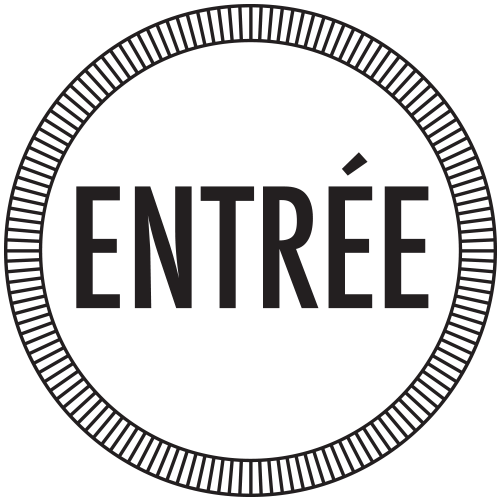Marit Følstad
Sense of Doubt
Hyper realistic and dark multichannel videos meet colorful neon and plywood in an immersive installation all tied together by a new ambient sound collaboration with Svarte Greiner. In her new site-specific exhibition at Entrée, Marit Følstad has enhanced the exhibition space to make a highly controlled environment, which invites to her distinctive hypnotic universe. The exhibition shares its title with David Bowie’s instrumental track from the 1977 album Heroes and follows the most recent, equally meditative chapters- Disorder (The Boiler Room), Something in the Way (Lautom) and No Strange Delight (Nordnorsk Kunstmuseum). Following the exhibition is an extensive essay by Steinar Sekkingstad. Opening reception at is followed by artist-talk and concert with Svarte Greiner at Landmark, Bergen Kunsthall.
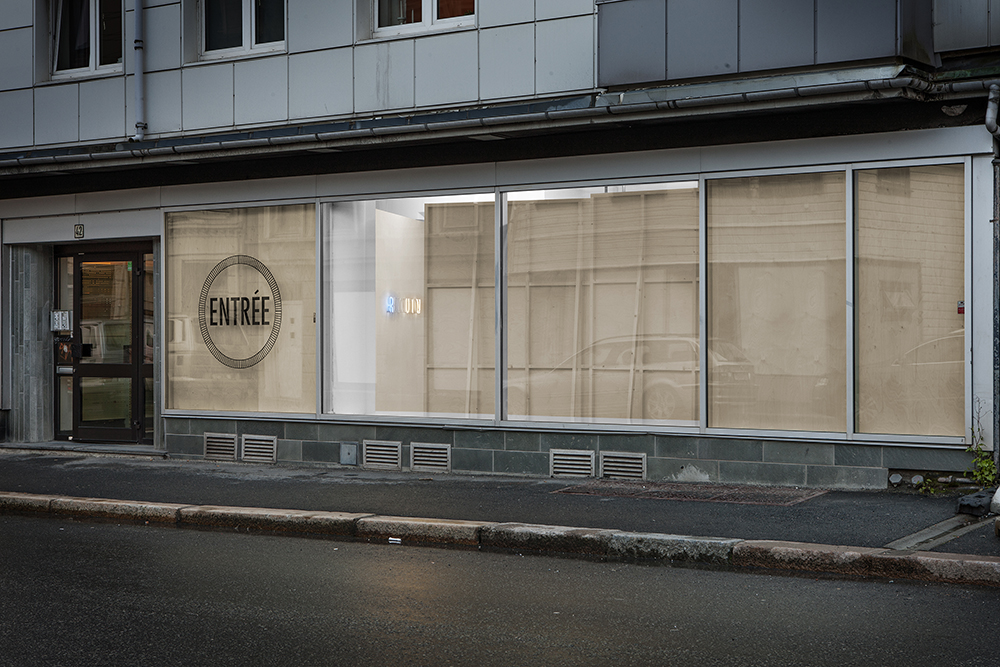
Entrée exterior, August 22- October 26, 2014. Photo: Vegard Kleven.

Installation view, Moss Garden. Photo: Vegard Kleven.

Image capture from Moss Garden, 2-Channel HD video installation.

Image capture from Moss Garden, 2-Channel HD video installation.
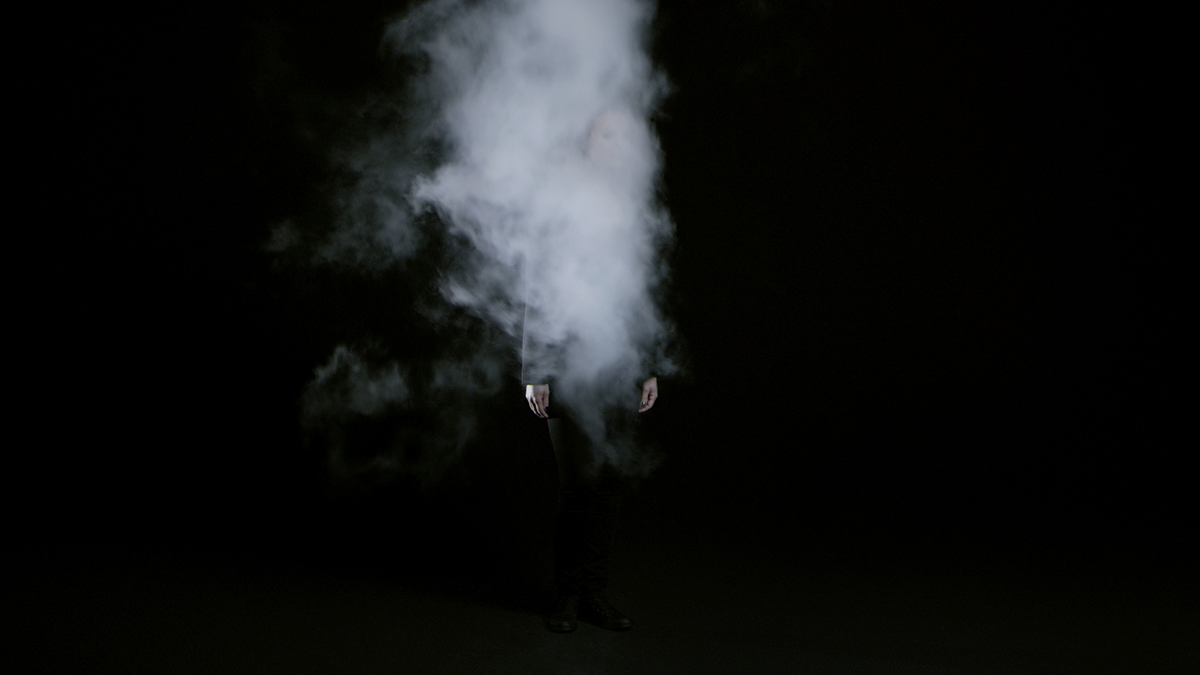
Image capture from Sense of Doubt, 2-Channel HD video installation.
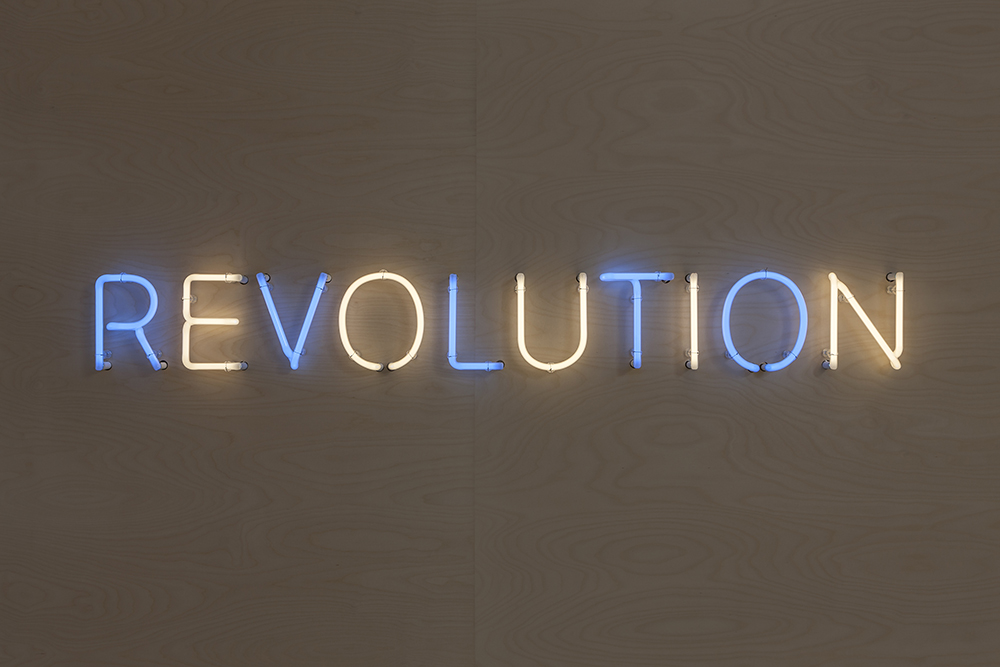 Installation view, Revolution. Neon and plywood. Photo: Vegard Kleven.
Installation view, Revolution. Neon and plywood. Photo: Vegard Kleven.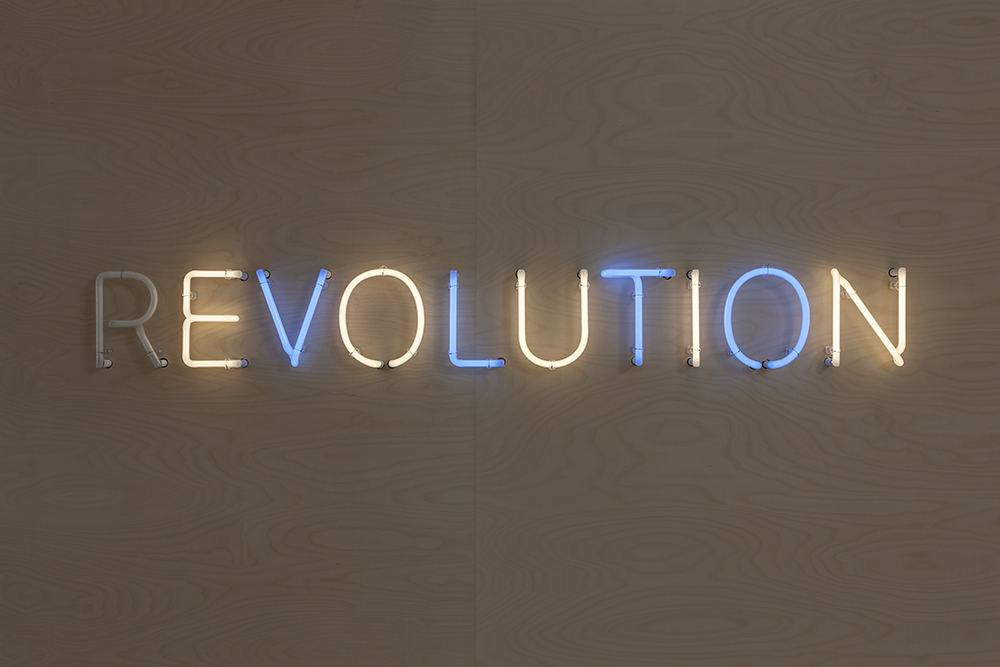
Installation view, Revolution. Neon and plywood. Photo: Vegard Kleven.
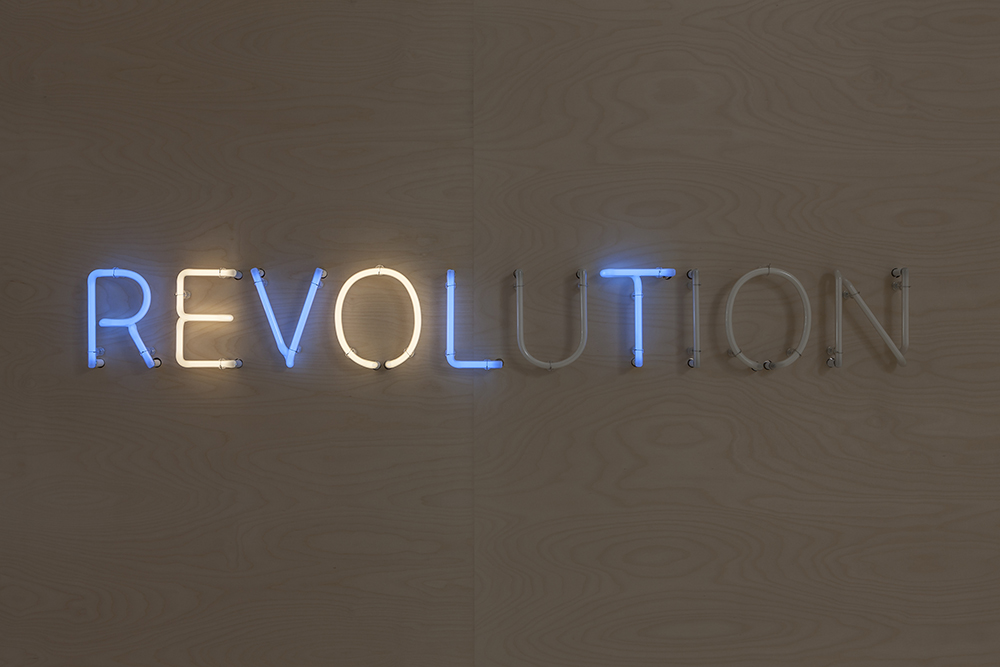
Installation view, Revolution. Neon and plywood. Photo: Vegard Kleven.
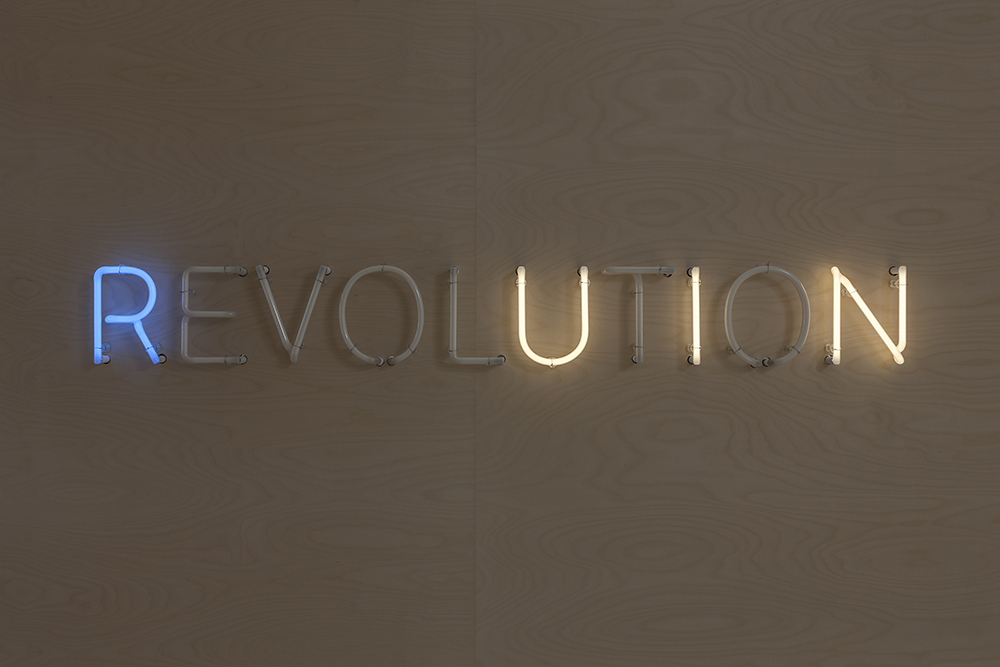
Installation view, Revolution. Neon and plywood. Photo: Vegard Kleven.
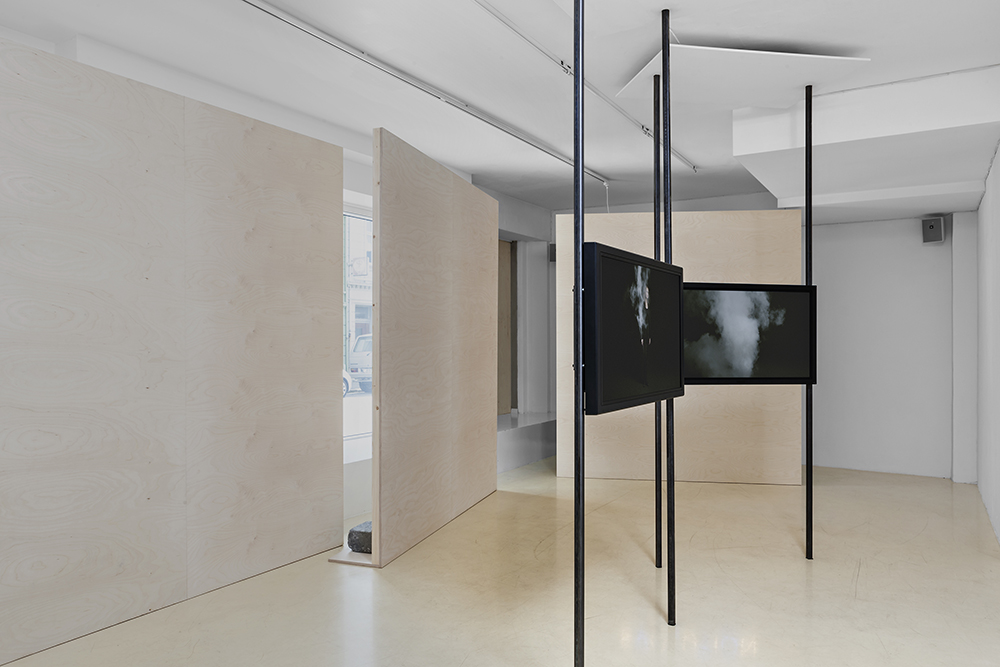
Installation view, Sense of Doubt. Photo: Vegard Kleven.
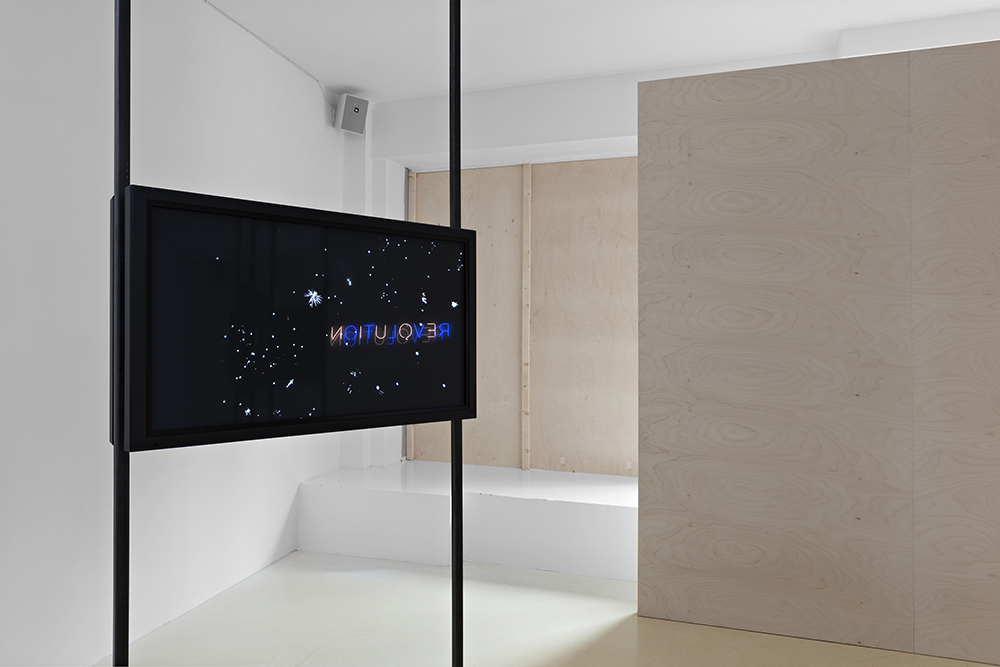
Installation view, Sense of Doubt. Photo: Vegard Kleven.
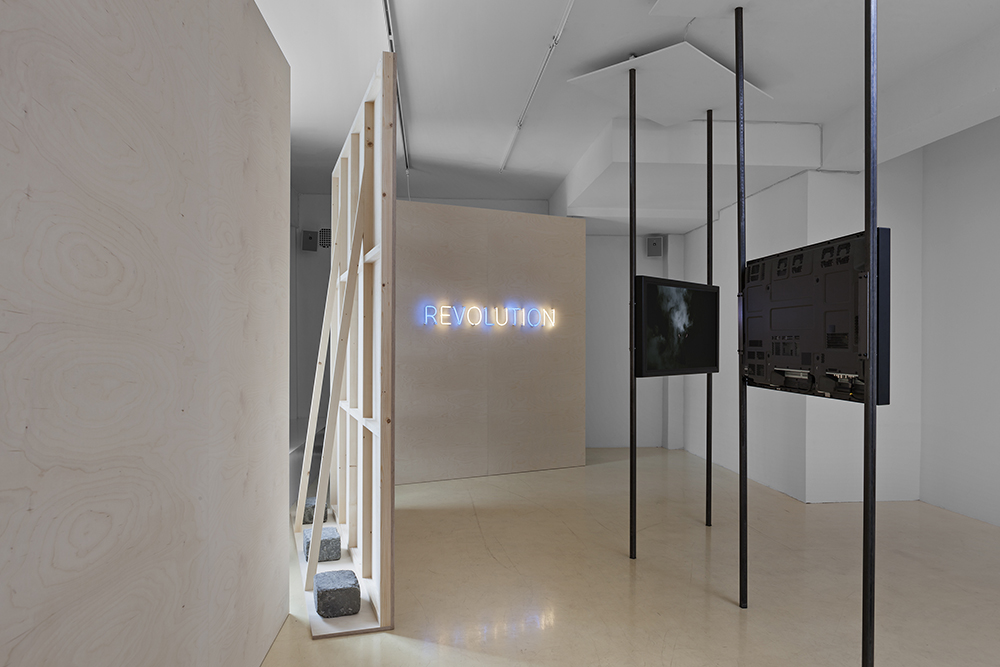
Installation view, Sense of Doubt. Photo: Vegard Kleven.
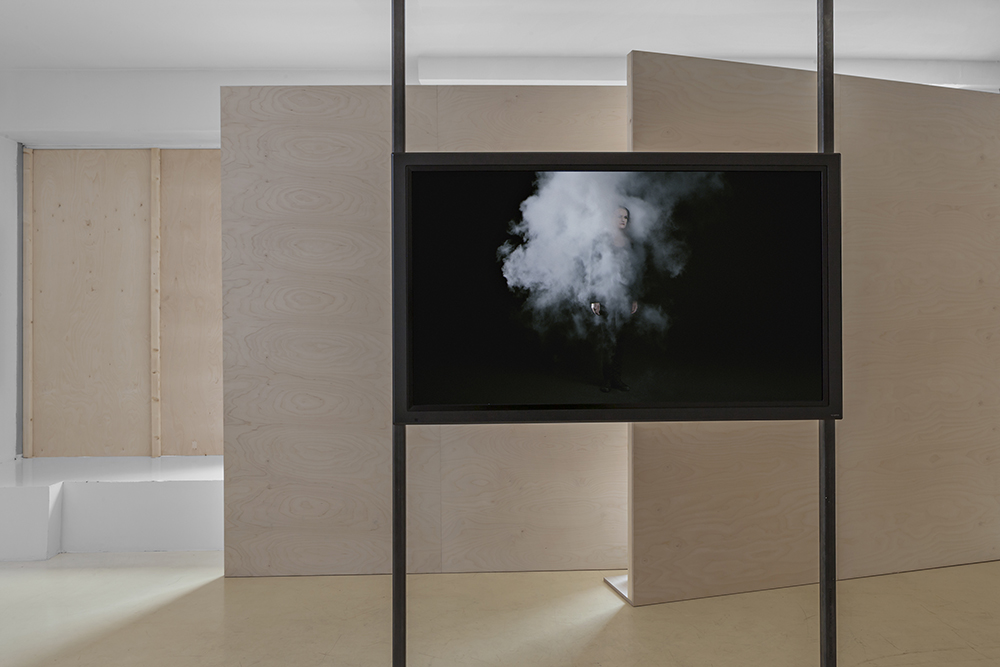
Installation view, Sense of Doubt. Photo: Vegard Kleven.
ON MARIT FØLSTAD’S SENSE OF DOUBT
By Steinar Sekkingstad
The gaze turned inward
Marit Følstad’s exhibition “Sense of Doubt” transforms the normally open, brightlylit gallery of Entrée, with its characteristic view of the street from large windows, into an enclosed, evocative, dark, intense world cut off from life outside. The exhibition establishes a clear dividing-line between inside and outside as you step into a world totally enveloped in its own atmosphere.
The concept ‘immersive’ is frequently used in English of installations where you are completely surrounded by the artwork. In Norwegian we lack a concept that similarly covers this particular type of experience. The concept is also used in VR computer technology, for example in a computer game where you find yourself ‘inside’ a game universe, and where the players experience that the simulated world is so perceptually convincing that they ‘are really there’, as part of the world of the game. The word ‘immersion’ also has a number of other layers associated with the feeling of sinking into something – literally (as in water in some kinds of Baptism), or metaphorically, into a state of mental absorption or deep involvement in some activity or thought (“a state of total immersion”).
Følstad often uses video in combination with other media to stage this kind of enveloping exhibition universe. “Sense of Doubt” consists of two new video productions and a neon and plywood installation. The two videos are distributed over four different monitors, embedded in specially built architectural modules that extend from floor to ceiling. The only light in the room comes from the dimly glowing video screens, and from the coloured neon text. The ever-changing light and the instrumental soundtrack fill the space and contribute to the experience of ‘stepping into’ the artwork.
All the same, there is also something about Følstad’s videos in themselves, independent of the form of presentation, that produces this experience of immersion. The people in Følstad’s videos seem to be caught in a state of inner contemplation, entirely absorbed in themselves, despite the physical actions to which they are often subjected. In the video that shares its title with the exhibition, Sense of Doubt, the figure on the screen is quite literally surrounded by (or immersed in) white smoke (CO2 gas) which repeatedly billows into the picture and almost obliterates the person.
In Moss Garden one of the screens is filled with incandescent explosions that start at the centre of the picture and expand directly towards us. Sparks flare up and die out in an infinity of beautiful explosions, set against a bottomless black background. Presumably we are seeing a relatively primitive firework display, but the black background gives the shower of sparks associations with astronomical phenomena, like the images from space we know from the Hubble telescope. Photographs from this telescope, which was sent out into space by NASA in 1990, often show impressively distinct images of celestial bodies, supernovas and black holes.
On the other channel of the video we see the back of the head of someone standing still and looking out at the explosions streaming directly towards her. Like Caspar David Friedrich’s wanderer, in his painting from 1818, standing with his back to us, overlooking a foggy landscape as threatening as it is overwhelmingly beautiful, Følstad’s figure too stands so to speak alone in the universe. As in the visual art of Romanticism, the sublime experience of nature first and foremost evokes a state of calm and inner contemplation.
From our position as viewers of the video, the head of the person on the screen gets in the way of the ‘action’. We are excluded from the spectacular and instead remain standing, looking at the back of the quite static head. The head seems to float bodilessly in space, and the long straight hair takes on an abstract quality like something almost eerily indefinable. Against the dark background, the head becomes as weightless as the shower of sparks, and looks most of all like a dark, floating celestial body that obscures the explosions coming towards us. In astronomy the concept of immersion, aptly enough, is used to describe a phenomenon where one celestial body disappears behind or into the shadow of another.
Ambient visuality
The two videos have clear resemblances to Følstad’s earlier works. Most of the videos feature a staged action where one person (usually Følstad herself) performs or is subjected to an action. In a few works the person herself performs an active, confrontational action, but in several of the videos of the past few years the person more usually stands quite still. She stands with a fixed, focused gaze as if frozen, apparently unaffected by the fact that the face or body is physically confronted by something originating outside the picture. In New Dawn Fades (2010) the face is struck with great force by a black sphere. In Everything Merges With the Night (2010) a similar sphere, filled with water, bursts over her head. Both of these films were shot using high-speed photography producing extreme slow motion, so that the actions are drawn out in time, giving an almost hyper-realistic clarity in each video frame.
The similarities among the various videos mean that they can be understood as parts of the same overall project. Følstad’s oeuvre emerges as a series of overlapping works where it is sometimes unclear where one work ends and the next begins. A recurring formal vocabulary with related references is repeated in work after work, without emptying the repetitions of meaning or enigmatic power. The effect of this continuity is that one work informs the next in a constantly accumulating series of interrelated works.
All the films deploy a similar stylistic formula. A camera is set up statically and shows exactly the same segment throughout the film. The person in front of the camera is meticulously positioned in the frame, against a neutral background. Each of the videos appears to consist of one continuous shot, without perceptible cuts or edits. The strict set-up recalls research documentation or a ‘screen test’ of an actor being auditioned.
The aesthetic expression in Følstad’s videos is nevertheless a long way from such sober, documentary expression. This has to do with the distinctive staging of the individual events played out in front of the camera. The videos have more in common with Surrealism’s filmic universe than with the aesthetics of documentary video art. Følstad dwells on the purely formal in the action that unfolds in front of the camera. The videos are spectacularly beautiful in their painstakingly detailed studies, in which Følstad abstracts and aestheticizes the action so that even the most banal event rises to a dramatic climax.
In several of the latest works, the confrontational, active subject of many of Følstad’s early videos has become a sculptural body; a malleable material which in the film frame fulfils the same function as the other pliant, fluid and ‘formless’ elements she uses. Like a sculptor with time as her material, she uses her camera to capture the formal qualities of small, fleeting moments – and amorphous materials like smoke, water or fire – phenomena that cannot otherwise be formed or fixed in a static, solid structure. The hair that ripples in slow motion as Følstad gives a dramatic toss of her head, repeating the same motion with tiny variations in an endless loop across three different screens (Something in the Way, 2012), has the same fluid, amorphous quality as the cigarette smoke that the male character in another work inhales and exhales with determined intensity (With The Lights Out, 2008). In other videos it is water or fire that fills the screen with similar organic forms that dissolve and vanish just as quickly as they arise.
The soundtrack for Følstad’s new videos has been composed by Svarte Greiner (Erik K. Skodvin) and consists of a sound-universe that is just as fluid as the action in the videos.1 Although there is a certain amount of linear development in the music, a compositional form with a progression from a starting point to an ending, this is still music where you first and foremost find yourself inside a universe of sound. The ambient sound fills the space just as structurelessly as the thick smoke in Sense of Doubt.
Ambient sound fulfils the same space-defining and enveloping functions as ‘immersive’ installation art. In the article “Ambient / Ambivalent” the art historian Ina Blom compares the spatial paradigm of contemporary art to ambient music: 1 Skodvin is a musician who works with sonorities and the material and physical qualities of sound. The music he creates under names like Svarte Greiner and Deaf Center has a dark, lingering or so-called ‘filmatic’ character. “designed to operate in the nexus between musical sound and environmental noise, ambient music shares with contemporary art precisely its interest in the exploration of the real, actual spaces in which we live and move about”.2 Svarte Greiner’s music is situated precisely in such a compositional tradition, where the music creates space more than it is perceived as linear development.
Once more this spatial paradigm can be applied to Følstad’s videos in themselves. They exist in what could perhaps be called an ambient visuality, where the action on the screen appears at once static and in continuous organic transformation. This ambient quality is particularly palpable in the videos that are based on slowmotion film and repetitions, or in the films where the main character is absent and the camera dwells exclusively on the mutable and uncontrollable forms that grow forth more or less by themselves. The firework-like explosions in Moss Garden have a parallel in an earlier work, the captivatingly beautiful video Disorder (2013), where lambent flames flicker across the screen as an indefinable, evidently easily combustible material flares up and flames across the black background only to die out. Følstad’s videos seem to establish a set of actions where the uncontrollable and the organically mutable define the form of the work.
The gaze turned outward
The contemplative atmosphere in Følstad’s exhibition seems to envelop the installation, sequestering the universe the artist creates in the exhibition space. But there are a few hints that point outward, to a world outside the work – among other places in the titles of the works and in the luminous neon work REVOLUTION, where language opens up a network of references to external factors.
The titles Sense of Doubt and Moss Garden are both borrowed from David Bowie, and are the names of two striking tracks from Bowie’s album “Heroes”. Within the dramatic structure of the LP, these two tracks, along with Neuköln, form a continuous instrumental suite on the B-side of the record. “Heroes” is the midmost album in the so-called Berlin trilogy, on which Bowie worked closely with Brian Eno in the period 1977-1979 (“Low” (1977), “Heroes” (1977) and “Lodger” (1979)). The two tracks to which Følstad refers can hardly be experienced in isolation from this larger contextual whole. That Følstad chooses two tracks from the same album indicates that the videos in the exhibition are two parts of the same work, in the same way as the songs on Bowie’s LP. Perhaps the way each track on a Bowie album always forms part of an overall unity can be compared to the way the individual video work by Følstad is related not only to the rest of the exhibition, but also to the way it forms part of the overall superstructure of the artist’s oeuvre. Sense of Doubt and Moss Garden are both two-part videos, and like the three-part suite on “Heroes” are compositions that are both fragmented and parts of a larger whole.3
Through the titles Følstad brings this whole Bowie universe to a reading of the exhibition. Once the connection has been made, it is not difficult to find a certain aesthetic affinity between Følstad’s works and Bowie’s Berlin period. The connection ‘fits’ in ways that are not necessarily fully articulated or explicitly formulated, but the Bowie universe and the Følstad universe strike one as a good match. Some pieces fall into place as Følstad’s filmatic universe engages in dialogue with the cool, dark, slightly futuristic atmosphere that suffuses Bowie’s three Berlin albums.
In a book about Brian Eno the music scholar Eric Tamm describes Eno’s crucial role in the work with “Heroes”. Tamm calls Sense of Doubt “a horrific, minimalistic soundscape with a deep, slow C-B-Bb-A piano motive that keeps returning, under filtered white-noise swooshings and isolated synthesizer chords in A minor, punctuated occasionally by an evil grating sound that can only be described as the yawn of the dead”.4 That such a “horrific, minimalistic soundscape” could have functioned as inspiration for Følstad’s exhibition seems a reasonable assumption.
David Bowie also appears as a reference in titles of earlier works. He finds himself in the company of artists like Joy Division, Brian Eno, Roxy Music, Nirvana or Blonde Redhead, all artists from whom Følstad has borrowed titles. Følstad’s choices of titles are open-ended enough to offer ample room for interpretation, even without knowing the pop music reference. With the Bowie reference, though, we can talk about the appropriation of a shared pop-cultural heritage. Once “Heroes” is involved in the exhibition, associations come rolling in for many of us: Bowie, Eno, Berlin, Tony Visconti, Iggy Pop, drug problems, the late 1970s, the Cold War etc. Any reference to this period in Bowie’s career will carry with it a whole set of consequent associations.5 And so an intertextual network of references arises, both among Følstad’s own works, and with the broader pop-cultural landscape in which they are placed. The interesting thing about Følstad’s use of quotations is nevertheless that the titles lie ‘alongside’ the work. The reference does not really give us a key that can decode the ‘meaning’ of the work. The exhibition is not about Bowie or Berlin in the 1970s, yet it adds an associative component that remains as a resonance for the work and plays into the experience.
Mourning a lost future
The last work in the exhibition is a text-based piece where the word REVOLUTION fills the space with cool, shimmering neon light. The glowing letters switch off and on in a particular cycle, changing the text over time. First REVOLUTION, which then changes to EVOLUTION, then REVOLT and finally RUIN.
hanges to EVOLUTION, then REVOLT and finally RUIN. In all its simplicity, consisting of a single word which through a negative elimination of letters changes into several new words, this work is both a piece of concrete poetry and a compressed narrative, where the series of highly charged concepts together make up an overall sweep of action. The first two words involve the avant-garde’s progressive belief in the future, the politically oppositional voice, faith in progress, development, upheaval and the hope for a new age. The third word, ‘revolt’, contains some of the same elements, but with a clearer anti-authoritarian attitude and implications of violent resistance against the establishment. Although the series of words runs in an endless loop, with no clear beginning or end, ‘ruin’ still seems to be the last word in this chain of concepts. The word implies decay and destruction, or the relics of a bygone era.
Putting the words together in this way suggests a certain movement: from the dawning optimism and upheaval of revolution to destruction and ruin. The work thus also points to melancholy or powerlessness – the impossibility of revolutionary upheaval without subsequent destruction. The word ‘ruin’ also suggests a melancholy associated with the transience of all worldly things. Historic ruins manifest the perishability of the creations of mankind. Along with the title of the exhibition, “Sense of Doubt”, this movement from revolution to ruin paints a scenario full of doubt and ambivalence.
The exhibition seems to evoke a vanished optimism about the future from a bygone time that now lies shrouded in a dark, obscure, misty mysticism. The concept of ‘hauntology’ describes the ghostlike presence of the past in the present. In the middle of the noughties the concept was adopted by a few music critics in an attempt to describe a tendency in British experimental pop music where this same ghost of the past – often an experience of superseded utopian revolutionary optimism – lies buried in a vague, introspective, crackly, scratchy soundscape based on nostalgic samples from the TV programmes, film music and radio plays of the sixties and seventies.6 The exhibition “Sense of Doubt” seems to have a similar ‘hauntological’ ambivalence. On the one hand Følstad evokes a period in the history of pop music typified by surplus and a revolutionary faith in artistic upheaval,7 and on the other hand we find ourselves positioned with the disillusioned retrospective gaze of the present. David Bowie’s “Heroes” was created amidst the polarized political worldpicture of the Cold War. Belief in revolution offered the hope that we could all be heroes. But for Bowie himself a doubt existed that balanced the optimism, as indicated by the deliberate use of quotation marks for the title and title track “Heroes”.
Følstad’s exhibition contains both aspects: on the one hand the optimism of Moss Garden, with the character viewing the shooting star, like a Romantic wanderer on the way into the unknown; and on the other hand the figure that sinks into the fog, is swallowed up and obliterated. Above all, the exhibition expresses a melancholy in this tension between the belief in revolution – the moment when everything lies open (progress, upheaval, a better future) – and the certainty of the subsequent loss of the same possibilities. But this ambivalence also brings hope: a flashback to the moment when this faith was so strong also insists that the possibility still exists. Revolt. Revolution. Evolution.
______________
1 Skodvin is a musician who works with sonorities and the material and physical qualities of sound. The music he creates under names like Svarte Greiner and Deaf Center has a dark, lingering or so-called ‘filmatic’ character.
2 Ina Blom, “Ambient / Ambivalent: Researching Sound and Vision”, in Daniel Birnbaum and John Peter Nilsson (eds.), Like Virginity, Once Lost: Five Views on Nordic Art Now, Propexus, 1999, p. 87.
3 Continuing to look for such parallels, one can perhaps compare the group of works that Følstad has called “The Black Videos” to the way a number of Bowie’s records from the end of the 1970s are often grouped together and associated with his ‘dark’ Berlin period.
4 Eric Tamm, Brian Eno and the Vertical Color of Sound, Da Capo Press, 1995, p. 158.
5 Bowie himself seems to relate actively to this phenomenon on his last album “The Next Day”. (2013). Both on the cover, where the iconic “Heroes” cover is used again (but this time with a large white square over the cover photograph), and in songs like Where Are We Now?, he looks back at his own Berlin period in the seventies.
6 The concept was frequently used from around 2005 by writers like Simon Reynolds and Mark Fisher. They borrowed it from Jacques Derrida’s book Spectres of Marx from 1994, and used it as a description of a loose network of mainly British artists, specifically associated with the recording label Ghost Box. Later the concept has spread among both music journalists and the art world, often as a term for the way our own time is haunted by historical memories. See for example Simon Reynolds, Retromania. Pop Culture’s Addiction to Its own Past, Faber and Faber, 2011, and Mark Fisher, Ghosts of My Life: Writings on Depression, Hauntology and Lost Futures, Zero Books, 2014.
7 In their Berlin period at the end of the seventies Bowie, Eno and Iggy Pop were a kind of veterans in a climate that was boiling over with aesthetic transgressions and artistic ambitions. After punk had begun to become formulaic around 1977 it was precisely the sombre proto-electronica of Bowie og Eno that was among the sources of inspiration for an explosion of creative DIY punk offshoots, from No Wave and electro-punk to industrial noise and minimalist hardcore punk.
